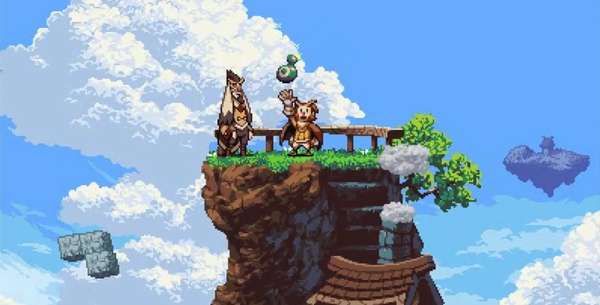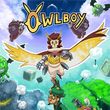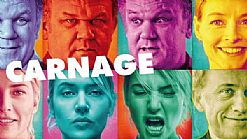Następny poziom: Owlboy – wywiad na temat gry ze studiem D-Pad
W rozmowie ze studiem D-Pad pytam o to, jak powstał i dokąd zmierza Owlboy, świetnie zapowiadająca się gra platformowa o latającym bohaterze. Twórcy opowiadają między innymi o tym, dlaczego uczynili swojego herosa niemym i jak powstał w ogóle jego niezwykły wygląd, który inspiruje wielu fanów do tworzenia fan-artów.

OwlBoy
Szymon Liebert: Dlaczego zaczęliście prace nad Owlboy’em i jaki był pierwotny pomysł na grę?
Simon Stafsnes Andersen: Pomysł zaczął się rozwijać około trzech lat temu. Gry z pikselami i 2D nie były wtedy raczej brane pod uwagę przez główną część branży, ale ja szukałem sposobu na to jak stworzyć interesujący projekt 2D, który bazował na mocnych punktach takich gier i wymyśliłem pomysł wertykalnego świata, po którym można latać. Pracując nad nim, pomyślałem, że ciekawie brzmi doprowadzenie do spotkania głównego bohatera z cywilizacją, która nie potrafi używać twojego języka, więc musisz znaleźć obejście tego problemu. To doprowadziło do pomysłu uczynienia głównego bohatera niemym. Większość gier ma milczących herosów, aby zwiększyć immersję, ale ja pomyślałem, że fajnie byłoby zrobić krok dalej i po prostu mieć postać niezdolną do mówienia.
Sowa jako główny bohater nie pojawiła sie od razu. Około miesiąca zabrało przeglądanie i rozpatrywanie różnych pomysłów na bohaterów, zanim wpadłem na pomysł wykorzystania sowy. Wtedy wszystko jakby ułożyło się w jedną całość.
Szymon Liebert: Kim jest Otus? Dlaczego piraci zaatakowali jego wioskę? Jaka jest fabuła gry?
Simon Stafsnes Andersen: Otus jest młodą sową, którą opiekuje się Asio, jego mentor. Nie zdradzę jednak tego, czemu piraci atakują jego wioskę. Będziesz musiał sam zagrać, żeby się dowiedzieć.
Szymon Liebert: Jak wygląda struktura gry? Czy to coś w rodzaju metroidvanii, czy może bardziej liniowe doświadczenie?
Simon Stafsnes Andersen: Po trochu i to i to. Jest nadrzędna ścieżka, którą możesz podążać w grze, prowadząca do zakończenia. Znajdziesz też mnóstwo obszarów do zbadania i innych questów do wykonania. W odróżnieniu od „metroidvanii”, nie jesteś nieustannie zamknięty w podziemiach i będziesz mógł zwiedzić także wioski oraz otwarte tereny, jeśli nie masz ochoty walczyć i podążać do bossa. Mam nadzieję, że stworzy to przyjemne, wyrównane tempo.
Szymon Liebert: Jakie są główne aspekty Owlboy’a w kwestii rozgrywki? Czy dominuje eksploracja, walka, czy łamigłówki?
Simon Stafsnes Andersen: Latanie jest ważną częścią gry. To oznacza, że nie możemy opierać się za bardzo na standardowej mechanice platformówkowej. Jednocześnie, Otus nie posiada żadnej własnej broni, więc będzie polegał na „strzelcach”, których zbierze podczas gry. Gracz będzie mógł przełączać sie między nimi i nosić ich jak przenośne wieżyczki. Ogólnie rzecz biorąc, przenoszenie obiektów jest ważną częścią łamigłówek i walki. Nie podoba nam się pomysł tworzenia gry, która skupia sie tylko na walce lub tylko na zagadkach, więc próbujemy dać graczom pewne zróżnicowanie.

Szymon Liebert: Owlboy może latać i łapać przedmioty. Jakich innych mocy możemy się spodziewać?
Simon Stafsnes Andersen: Każdy ze strzelców będzie miał unikalną moc. Są jeszcze kapelusze i czapki, które zapewniają specjalne właściwości osobom, które je ubiorą. Oprócz tego, w grze pojawią sie tez przedmioty dodatkowe, kt&´re będzie można używać na sobie i zyskać pewien limitowany efekt.
Szymon Liebert: Czy możesz określić jak długa będzie gra? Myśleliście też o trybach multiplayer?
Simon Stafsnes Andersen: Obawiam się, że nie mogę odpowiedzieć. Mamy nadzieję, że gra będzie wystarczająco długa, aby okazała się przyjemna. Nie martwimy się za bardzo długością gry, jeśli sama przygoda jest satysfakcjonująca. Jest wielu recenzentów którzy potrafią dać grze złą ocenę tylko dlatego, że jest krótka, ale ja uważam, że więcej dają mi gry takie jak Portal, od gier, w które mógłbym grać może i ze sto razy dłużej. Różnica polega po prostu na jakości czasu spędzonego z grą.
Co do trybu multiplayer, w tej chwili nie mamy nic do ujawnienia.
Szymon Liebert: Jest sporo fanowskich grafik na twojej stronie. Czy to oznacza, że wasz unikalny styl graficzny okazał sie sukcesem? Jak podeszliście do tego aspektu gry?
Simon Stafsnes Andersen: Tak naprawdę jestem zaskoczony, że otrzymaliśmy tak dużo fan artów. To niesamowite, że projekt, który naszkicowałem trzy lata temu teraz jest przerabiany przez niezliczoną liczbę ludzi. To także wielki zaszczyt.
Styl graficzny nie był raczej planowany w jakiś sposób. To po prostu wizja, którą wyobraziłem sobie w mojej głowie. Można powiedzieć, że jestem pikselowym purystą, więc szczycę się tym, że poświęcam sporo wysiłku w tworzenie grafik bez pomocy gradientów i filtrów w stylu rozmycia. Jest coś niezwykłego w efekcie, jaki uzyskujesz, gdy opierasz się na samej palecie kolorów. Wydaje mi się też, że unifikuje to całościowy wygląd gry.
Zawsze staram się podkreślić kształt bohatera, kiedy go projektuję. Musisz być w stanie rozpoznać go momentalnie. Wydaje mi się, że w wielu pracach brakuje odrobiny przemyślenia. Masz około trzech sekund na zainteresowanie graczy swoim projektem, gdy trafiają na niego na stronie internetowej lub w magazynie, więc dla mnie naprawdę ważne jest złapanie uwagi danej osoby w tym tak krótkim czasie jaki mamy.

Szymon Liebert: Kiedy otrzymamy ostateczną wersję Owlboy’a i ile będzie kosztowała? Macie plany odnośnie innych platform?
Simon Stafsnes Andersen: Ponownie, nie mogę udzielić komentarza w tym momencie. Planowaliśmy wydać grę w 2011 roku, ale będziemy musieli poświecić jej nieco więcej czasu. W kwestii konwersji, zobaczymy co da się zrobić. Wydanie pecetowe jest naszym priorytetem. Zobaczymy co wydarzy się dalej.
Następny poziom: OwlBoy
- Pierwszy poziom: opis gry i wrażenia z dema
- Drugi poziom: wywiad z twórcami
- Trzeci poziom: film z komentarzem
Interview with Simon Stafsnes Andersen on Owlboy:
When did you started working on Owlboy and what was the first concept for the game?
The initial development of the idea came about around three years ago. 2D games and pixel games were not seen as viable options for the main game industry at this time, and I was thinking of way to create an interesting 2D concept that played on the strenghts of the medium and came up with the idea of creating a vertical world that revolved around flying. As I developed it, I thought it would be interesting to have the main character meet civilizations that couldn't speak your language, and you had to work around this problem. This developed into the idea of making the main character a mute. Most games have silent protagonists to create immersion, but I thought it would be interesting to take it a step further and have a character that is incapable of speech.
Having an owl for the main character wasn't something that was always there though. It took a month of going through different character ideas before I came up with the idea of using an owl. Everything kind of fell into place from there.
Who is Otus? Why did sky pirates attack his village? What’s the story of the game?
Otus is a young owl to is under the care of Asio, his mentor. As for why the pirates are attacking his village though, I cannot say. You'll have to play the game to find out.
What’s the structure of the game? Is it something like metroidvania or more like a “linear” experience?
It's a little of both. There's an overall path to follow in the game that leads to an ending, but you have plenty of areas to explore and other quests to go on. Unlike "Metroidvanias", you're not constantly stuck in a dungeon and will have towns and open areas to check out when you don't feel like fighting your way to a boss. Hopefully, it'll feel like a nice, even pacing.
What are the main themes of Owlboy gameplay-wise? Is it exploration, combat or puzzles?
Flying is a big part of the game. This means we can't rely on standard platform mechanics quite as much. At the same time, Otus has no weapons of his own, and will rely on 'Gunners' he gathers through out the game. The player will be able to switch between these and carry them around like mobile turrets. Carrying objects becomes a big part of puzzles and combat in general. We don't like the idea of making a game that just focuses on only combat or only on puzzles, so we try to give the player some variation.
Owlboy can fly and grab stuff. What other powers can we expect?
Gunners will each have unique powers for one. There are also hats, which grant special powers when worn, and then there's support items the player can use on themselves for a limited effect.
Are you able to say how long will the game be? Have you ever thought about multiplayer modes?
I'm afraid I can't say. Hopefully long enough to be enjoyable. We're not that concerned with the length of the game as long as the ride was enjoyable. There are many reviewers out there that will give a game a bad score simply for being short, but I find that I'm left with something a lot more substantial after a game like Portal, than I am from a game that would be maybe a hundred times longer. The difference is simply quality for the time spent on the game.
As for multiplayer, I have nothing to announce at this time.
There’s a lot of fanarts on your website. Does it mean that your unique graphic style was a success? How did you design this aspect of the game?
I'm actually pretty surprised that we've received this much fan art. It's kind of amazing to think that the design that I sketched three years ago is now being redrawn by countless people and it's a great honor.
The visual style wasn't planned really. It was simply the vision as I pictured it in my head. I'm a pixel purist you could say, so I take pride in putting serious effort into the art that I do without the aid of gradients or blur filters. There's something special about the effect that you get when you rely on a stright palette, and I find that it also unifies the look of the game as a whole. I always try to enunciate the shape of a character when I design them. You need to be able to recognise them instantly. I feel like a lot of projects simply lack a bit of design sense. You have about three seconds for a player to get interested in your project when they flip by it on a website or magazine, so it's really important for me to capture that person's interest in the brief moment we have.
When will we get the final version of Owlboy and how much will it cost? Are you planning to port it to other platforms?
Again, I can't comment on this at the moment. The planned release was somewhere in 2011, but we might have to put in a little more time to get it right. As for ports, we'll see what we can do. The PC release is our first priority. We'll see where it goes from there.
´
więcej na temat
- Owlboy nadleci za kilka miesięcy – studio D-Pad skończy grę do wiosny
- Następny poziom: Owlboy – gorące demo gry jest tam i czeka na Ciebie
- Następny poziom: Owlboy – nadchodzi następca kultowego Cave Story?
- Folklands
- Legends BMX
- Caligo
- Morkull Ragast's Rage
- Only Way is Down
- Miryam: The Polluted Land
- MeMic
Opisywane gry
 Owlboy
OwlboyPopularne na blogu gry same się nie przejdą!
- Próba ustanowienia Światowego Rekordu Guinnessa w Kinect Sports już w sobotę!
- Bolidy i hatchbacki w listopadowym dodatku do Forza Motorsport 4
- Nowe funkcje w Halo Waypoint i animowany komiks ze świata gry
- Oryginalnie i urokliwie – gra Bastion nadchodzi
- Gabriel z Castlevania: Lords of Shadow ruszy na kolejną wyprawę w tym miesiącu
- Nowe obrazki z Crimson Alliance
Najnowsze na blogu gry same się nie przejdą!
- Sympatyczni i niepotrzebni – recenzja filmu Ratchet i Clank
- Dark Souls III ma w sobie nowy ogień – nowa nadzieja po becie multiplayer
- Broforce – Robocop, Rambo i Ripley w browurowej grze – test wersji alfa
- Karol i Witek przegrali „Powstanie Warszawskie” – recenzja filmu
- Pixel Piracy - piracić czy nie piracić? – test wersji alfa
- Kiedy Xbox One wyjdzie w Polsce? Czy wystarczy PS4 na polską premierę? – plotki z branży

